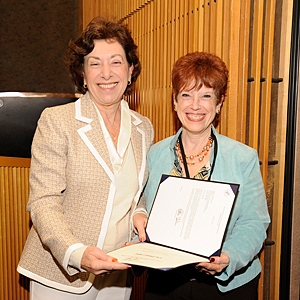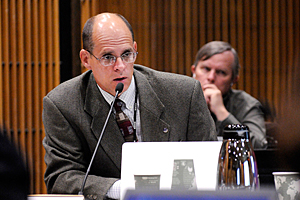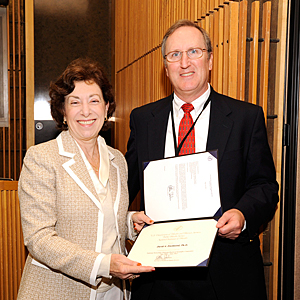NTP board gives go ahead for PAH research and systematic review
By Robin Mackar

Left to right, Birnbaum, Bucher, Eastmond, and Mary Wolfe, Ph.D., director of the NTP Office of Liaison Policy and Review, listened carefully to public comments and board discussions on high profile topics. (Photo courtesy of Steve McCaw)
When the NTP Board of Scientific Counselors (BSC) met on Dec. 11, 2012, two main agenda items took center stage — polycyclic aromatic hydrocarbons (PAHs) and systematic review. The board endorsed NTP’s multi-year PAH research concept with some minor tweaks, and accepted a working group report on systematic review.
Polycyclic aromatic hydrocarbons
Scott Masten, Ph.D., who heads the NTP Office of Nominations and Selection, provided a brief introduction to the research concept on PAHs. (http://ntp.niehs.nih.gov/NTP/About_NTP/BSC/2012/December/PAHResearchConcept_508BE.pdf) Masten explained that an NTP concept represents a high-level look at the scope, approach, strategy, and direction that NTP would take in an area of interest, but is not to be thought of as a study design.
NTP toxicologist Cynthia Rider, Ph.D., lead for the PAH research effort, provided details about PAHs and the NTP approach to studying them. She said that PAHs are a large class of compounds found virtually everywhere in our environment. They occur naturally in petroleum and coal, or are created and released into the environment through natural events, such as forest fires and volcanoes. Rider noted that the 2010 Deepwater Horizon oil spill also reignited public concern over the human and ecological health hazards of PAHs.
A flexible iterative process
“PAHs always occur in complex mixtures. There are at least 1,500 different PAHs, and there are numerous ways that humans can be exposed, including through food, inhalation, or through the skin,” Rider explained. NTP plans to look at a variety of health effects, using a battery of toxicity tests, including experimental animals and cell culture systems.
Rider discussed the pros and cons of two different approaches for assessing cumulative effects of PAHs — the component-based, or relative potency factor approach, and the whole mixture approach. She said the NTP proposal would contribute data to both approaches, and that they would be flexible and iterative. “The testing program will be built in units, with each round of testing informing the next,” Rider explained.
Using PAHs to move mixtures research forward
NTP plans to test both individual PAHs and complex environmental mixtures. Understanding how combined environmental exposures affect disease pathogenesis, or development, is a high priority for NIEHS and NTP. It is identified as Goal 4 in the NIEHS strategic plan and was the subject of a workshop in 2011.
Board members provided suggestions for moving the research forward, to ensure NTP looks at the breadth of endpoints or health effects PAHs may be causing, including endpoints relevant to known human effects.
“The board is supportive of the NTP’s efforts to help us better understand the health effects from PAHs. This effort will also help move the whole field of mixture science forward,” said BSC chair David Eastmond, Ph.D., of the University of California, Berkeley.
Board member Robert Chapin, Ph.D., of Pfizer, whole-heartedly agreed. “The NTP needs to be doing this. It needs to take on mixture science and wrestle it to the ground,” he said.
Systematic review process
Most of the afternoon was spent discussing the NTP approach (http://ntp.niehs.nih.gov/NTP/OHAT/EvaluationProcess/RevisedDraftNTPApproach_508.pdf) for systematic review that is being led by the NTP Office of Health Assessment and Translation (OHAT). Systematic review allows for more transparency of how NTP health assessment conclusions are determined (see story).
The board members listened to three public comments by phone and received all written public comments. (http://ntp.niehs.nih.gov/?objectid=18D4D22C-F78A-54D5-7D61121305FCF86C)
Both NTP Associate Director John Bucher, Ph.D., and Eastmond reminded the board that its charge was to accept or reject the NTP BSC draft working group report (http://ntp.niehs.nih.gov/ntp/about_NTP/BSC/2012/December/DraftReport_LiteratureBasedEvi.pdf) on the approach to systematic review. The board unanimously accepted the report (see text box).
Andrew Rooney, Ph.D., and Kris Thayer, Ph.D., of OHAT took turns walking the board through the draft approach, answering questions, and talking about next steps, including developing several case studies to show how the process works.
(Robin Mackar is the news director in the NIEHS Office of Communications and Public Liaison, and a frequent contributor to the Environmental Factor.)

Rider, who is relatively new to NTP, shared her extensive knowledge about PAHs with the board. (Photo courtesy of Steve McCaw)

BSC Working Group Chair Goldman summarized the draft report on evaluating NTP’s approach for reaching conclusions for literature-based evidence assessments. (Photo courtesy of Steve McCaw)

Birnbaum and Zelikoff share a smile, after Birnbaum presented her with a certificate of appreciation. (Photo courtesy of Steve McCaw)

Masten, who oversees the nomination and selection process for NTP studies, shared information about how the PAH research concept came to fruition. (Photo courtesy of Steve McCaw)

OHAT Director Thayer, left, and OHAT Deputy Rooney, reviewed their slides on the systematic review process, before presenting to board members. (Photo courtesy of Steve McCaw)

Birnbaum, left, took a few minutes during a busy BSC meeting to show appreciation to board members whose appointments ended on December 27, 2012. Birnbaum thanked Eastmond, above, for his service, especially his role as chair. Eastmond, Judith Zelikoff, Ph.D., of New York University Langone Medical Center, Elaine Faustman, Ph.D., of the University of Washington, and Dana Loomis, Ph.D., from the University of Nebraska Medical Center, all completed their appointments in December. Faustman and Loomis were unable to attend the meeting in person. (Photo courtesy of Steve McCaw)
"2012 papers of the ..." - previous story ![]()
![]() next story - "Environmental health atlas provides ..."
next story - "Environmental health atlas provides ..."
January 2013 Cover Page


